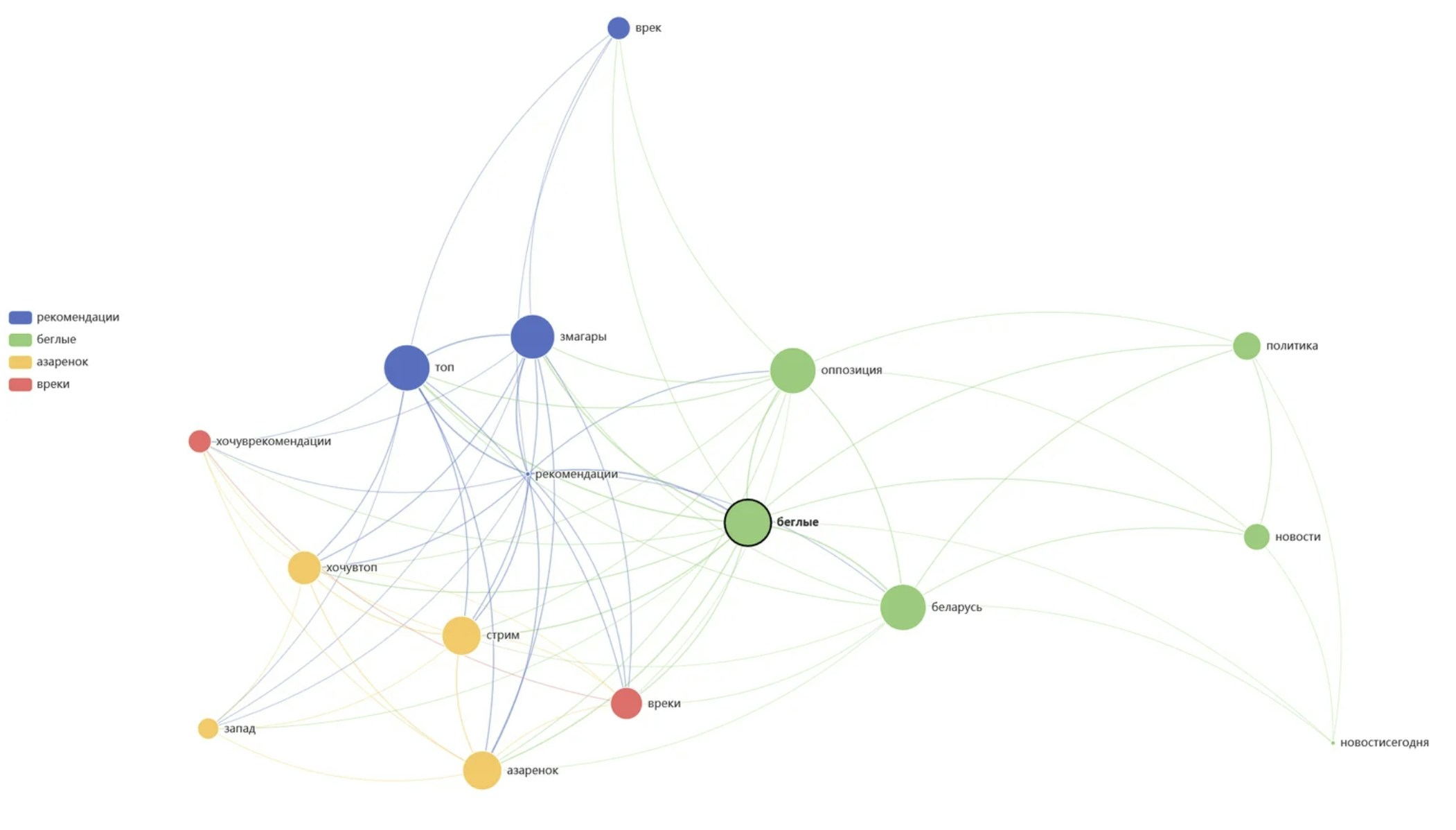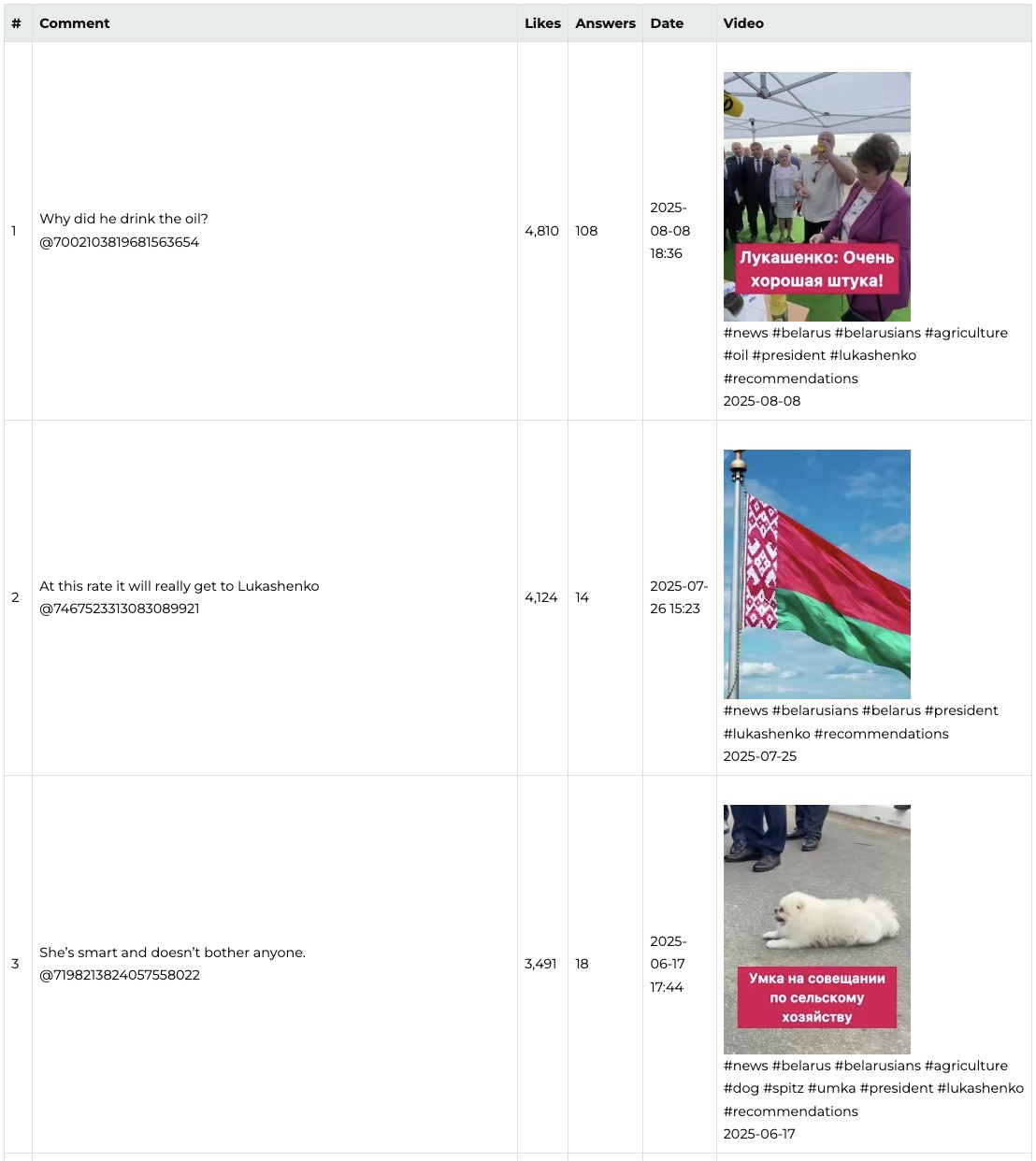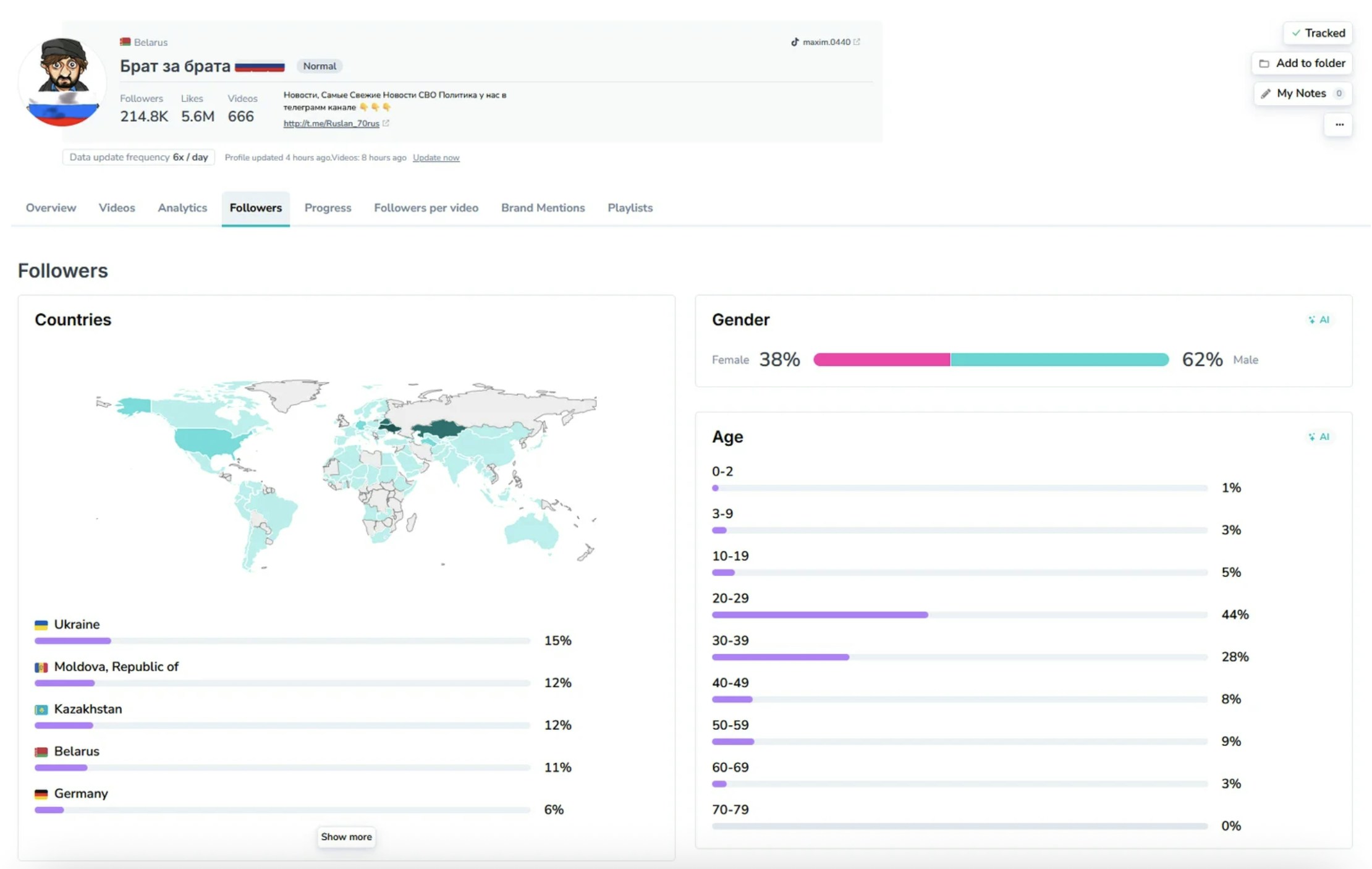FactCheck.LT 연구팀의 교훈:
TikTok은 춤 도전과 미미에서 시작해 이야기 구성과 정보 전파에 중요한 플랫폼으로 발전하였습니다. 그 특유의 시각적이고 네트워크화된 콘텐츠 생태계를 통해, 연구자, 팩트 체커, 정책 팀에게 실시간 대중 의사소통 인사이트를 제공합니다.
이 가이드는 FactCheck.LT가 동유럽의 여러 선거 주기에 걸쳐 실시한 광범위한 연구를 바탕으로 TikTok에서의 허위 정보를 모니터링하는데 있어 실질적이고 근거에 바탕을 둔 작업 흐름을 제공합니다.
디스인포메이션 연구에 있어서 틱톡 분석이 왜 중요한가요?
TikTok의 알고리즘은 문화적 트렌드를 단순히 반영하는 것이 아니라, 그것을 적극적으로 형성합니다. 우리의 분석은 정치적 내러티브가 꾸준히 엔터테인먼트 콘텐츠, 바이럴 사운드, 그리고 크리에이터 네트워크를 이용하여 전통적인 뉴스를 거의 소비하지 않는 대상들에게 도달하는 방법을 보여줍니다.
이 플랫폼의 트렌드 엔진은 사운드, 해시태그, 효과, 그리고 크리에이터 간의 상호 연결된 관계를 통해 작동합니다. 주제 주변의 동시발생을 매핑하면, 주류 커뮤니티로 연결되기 시작하는 비주류 내러티브를 식별하고, 디스인포메이션 확산에 대한 조기 경고 신호를 제공할 수 있습니다. 이 환경에서는 트렌드가 고립되어 형성되는 것이 아니라 다른 트렌드와의 관계에서 형성되므로, 맥락이 모든 것이 됩니다.
어떤 핵심 요소들을 모니터링해야 할까요?
1. 해시태그 네트워크와 내러티브 구조화
디스인포메이션은 거의 한 개의 해시태그로만 전파되지 않습니다. 대신, 서로 인접한 해시태그의 클러스터를 통해 복잡한 구조를 형성하며, 이는 다른 커뮤니티 간의 다리 역할을 합니다. 우리의 연구에서는 벨라루스 TikTok의 유해 해시태그가 어떻게 건강 중심의 태그가 정치 콘텐츠로의 다리 역할을 하는지를 밝혀냈습니다. 이를 통해 그렇지 않았다면 별개로 남아 있을 커뮤니티 경계를 넘어서서 이야기가 전달될 수 있었습니다.
핵심 인사이트는 주요 해시태그뿐만 아니라 관련 태그 전체를 모니터링하는 것입니다. 높은 중복성을 가진 인접 태그, 커뮤니티 클러스터, 주변 노드들은 종종 다음 틀의 진화를 예고합니다. 이러한 관계 패턴을 시간에 따라 분석함으로써, 핵심 틀과 기회주의적인 탈취를 구별할 수 있습니다.

이미지 출처: Exolyt
7월 업데이트에서 Exolyt는 매우 복잡하고 인상적인 관련 해시태그 차트에 사용자 정의 시간 범위를 선택할 수 있는 기능을 추가하였습니다. 이 차트 분석을 통해 더욱 방대한 해시태그인 "змагары" / "fighters"에 대한 조사가 진행되었습니다.
2. 언어 간의 전달자로서의 오디오 템플릿
오디오 템플릿은 텍스트 기반 콘텐츠보다 빠르게 언어적 장벽을 넘어 아이디어를 전달합니다. 바이럴 오디오를 통해 전파되는 정치 슬로건은 동일한 행동 요구사항이 외관상 관련 없는 콘텐츠 아래에 나타나는 것으로, 이는 서사 확대의 가장 효과적인 방법 중 하나를 대표합니다. 선거 기간 동안, 이 패턴은 자연스럽게 퍼져나가는 것이 아닌 조직적인 활동의 지표로 지속적으로 관찰되었습니다.
다양한 언어 커뮤니티에서 오디오 채택의 속도는 서사 구성에 대한 중요한 정보를 제공합니다. 특히 시간이 짧게 압축될 때, 동일한 오디오 템플릿이 여러 언어 맥락에서 동시에 나타나면, 이는 자연스러운 바이럴 확산보다는 조정된 확대를 나타냅니다.
3. 댓글 인텔리전스와 그라운드 트루스
댓글 섹션은 주요 콘텐츠가 신중하게 숨기는 조정을 종종 드러냅니다. 2025년 여름 동안 TikTok 댓글에 대한 우리의 분석은 댓글 타임라인과 문구 수준의 검토가 어떻게 장난스러운 멤에서 고의적인 설득 시도와 브리게이딩 작업을 구별하는 데 도움이 되는지를 보여주었습니다.

이미지 출처: Exolyt
연구 자료: 프로-정부 벨라루스 TikTok 코멘트 분석
다양한 비디오에서 반복적으로 나타나는 표현, 시간을 압축한 코멘트 폭발, 그리고 복사-붙여넣기 형식의 콜 투 액션은 조직적인 활동의 명확한 신호로 나타납니다. 관련 없는 콘텐츠에 걸친 동일한 메시지의 시간적 압축은 조직적인 활동이라는 것을 강력하게 증명하는 특히 강력한 증거로, 이는 자연스러운 커뮤니티 반응이 아님을 보여줍니다.
4. 크리에이터 네트워크와 마이크로 인플루언서 체인
나레이티브는 놀라운 효율성으로 마이크로 인플루언서 체인을 따라 전파됩니다. 가장 효과적인 영향력 운영은 다양한 커뮤니티에 걸쳐 있는 크리에이터를 찾아내고, 다양한 주제에 걸쳐 정치적 틀을 반복적으로 심어놓습니다. 이러한 경계를 넘나드는 계정들은 나레이티브 확산에 있어 중요한 노드가 됩니다.
개별 크리에이터의 지표를 추적하는 것뿐만 아니라 성장의 급증, 태그 간 활동, 관객의 중복, 그리고 협업 패턴 등 네트워크 수준의 패턴 분석이 필요합니다. 비슷한 콘텐츠를 짧은 시간 내에 게시하거나 동기화된 참여 패턴을 보이는 네트워크는, 자연스럽게 형성된 커뮤니티 동적성을 넘어서는 조정의 가능성을 나타냅니다.
5. 지역-언어 커뮤니티 신호
TikTok의 커뮤니티 구조는 #BookTok 및 #PoliTikTok과 같은 해시태그를 중심으로 구성되어 있어, 이야기의 흐름을 이해하는데 분석적인 단축키를 제공합니다. 지역과 언어별로 주제를 세분화하면, 자연스럽게 겹치는 부분이 적은 커뮤니티가 갑자기 태그나 사운드를 공유하게 되는 경우, 이는 외부 개입이나 타겟팅된 이야기 구축을 나타냅니다.
우리의 연구는 벨라루스, 폴란드, 루마니아를 걸쳐 이주민, 국경, 소수 언어 사용자들이 종종 서사 테스트의 초기 대상이 된다는 것을 보여주었습니다. 이러한 커뮤니티들은 메시지가 더 큰 인구로 확장되는 것을 테스트하는 실험장 역할을 하며, 이는 그들을 중요한 초기 경고 지표로 만듭니다.
*Exolyt 프로팁
소셜 데이터를 분석할 때 다국어 소셜 리스닝의 복잡성을 다루는 것은 큰 도전일 수 있습니다. 이미 고려해야 할 문화적 뉘앙스가 많은데, 이제 영어 중심의 데이터 편향을 극복하고 다른 언어의 풍부함을 진정으로 이해하며, 보다 포괄적이고 정확한 글로벌 인사이트를 도출해야 합니다.\n오디오의 중요성을 인식하며, Exolyt는 더 나은 콘텐츠 분석을 지원하기 위해 비디오 전사를 도입하였습니다.
따라서, 만약 이러한 도전에 직면한 소셜 리스닝 전문가라면, Exolyt를 시도해보시고 즉시 동영상 콘텐츠 인사이트의 편리함을 경험해보세요 🔥
6. 캡션을 넘어선 시각적 인텔리전스
영향력 작전은 점점 더 화면에 표시되는 텍스트, 로고, 또는 자막에서 언급하지 않는 시각적 요소에 메시지를 내장합니다. 프레임 레벨 분석은 키워드만을 모니터링하는 시스템이 완전히 놓치는 개의 소리와 자막이 없는 내러티브를 포착합니다. 이 시각적 레이어는 종종 가장 민감하거나 논란의 여지가 있는 메시지를 포함하고 있으며, 검색 가능한 텍스트에서 의도적으로 분리되어 있습니다.
캡션 내용과 캡션 외 내용의 차이는 의도와 세련도를 나타냅니다. 감지 시스템을 회피하도록 설계된 콘텐츠는 주요 메시지를 시각적으로 내장하면서 무해한 캡션을 유지함으로써, 합리적인 부인 가능성을 생성하고 의도된 대상에게 메시지 전달을 보장합니다.
7. 시간 패턴 인식
진정한 트렌드는 성장과 참여에서 자연스러운 숨결 패턴을 보여줍니다. 비유기적인 추진력은 평소와 다른 시간에 급증하거나, 기계적으로 규칙적인 간격을 보이거나, 자동화보다는 인간의 커뮤니티 행동을 나타내는 반복적인 일일 리듬에 빠집니다.
해시태그 성장 곡선, 게시 빈도 패턴, 그리고 댓글 속도를 겹쳐보면, 조작된 확산과 자연스러운 커뮤니티 참여를 구분하는 특징이 나타납니다. 이러한 시간적 지문은 크리에이터 네트워크 분석과 콘텐츠 유사도 지표와 결합될 때 특히 가치있게 됩니다.
Exolyt에서 캡처된 크리에이터 네트워크 분석 예시.

이미지 출처: Exolyt
디스인포메이션 연구를 위한 체계적인 모니터링 워크플로우를 어떻게 유지할 수 있을까요?
- 범위와 파라미터 설정
효과적인 모니터링은 선거, 이민 주제, 건강에 대한 잘못된 정보, 또는 지역 정치와 같은 위협의 풍경을 명확하게 정의하는 것에서 시작합니다. 성공적인 프로그램은 3~5개의 핵심 해시태그, 2~3개의 트렌드 사운드, 그리고 커뮤니티 간에 영향력을 발휘하는 10~20명의 주요 크리에이터를 포함한 시드 파라미터를 설정합니다.
목표는 "우편 투표 절차에 대한 허위 주장의 신흥 추세 감지"나 "소수 언어 커뮤니티를 대상으로 한 국경 간 선전 추적"과 같이 명확하고 측정 가능해야 합니다. 이러한 구체성은 집중적인 데이터 수집을 가능하게 하며, 분석 효과를 희석시키는 범위 확장을 방지합니다.
- 네트워크 매핑 및 관계 분석
각 시드 해시태그에 대한 포괄적인 관계 맵을 구축하면 연결된 콘텐츠와 커뮤니티의 넓은 생태계를 드러냅니다. 이러한 맵은 높은 중복이 있는 이웃, 커뮤니티 클러스터링 패턴, 그리고 종종 신흥 내러티브 방향을 시사하는 주변 노드를 강조합니다.
이러한 관계 네트워크의 주간 스냅샷은 시간에 따른 변화를 포착하여, 외부 이벤트나 내부 커뮤니티 동향에 대응하여 클러스터가 어떻게 형성되고, 병합되거나 분열하는지를 보여줍니다. 주변 노드는 특히 주목할 만한데, 이들은 종종 다음 단계의 서술 구조를 예고하는 경우가 많습니다.
- 크리에이터 인텔리전스 및 네트워크 분석
다양한 커뮤니티를 아우르거나 반복적으로 모니터링 태그와 사운드 근처에 나타나는 계정의 관찰 목록을 개발하는 것은 네트워크 수준 분석의 기초를 마련합니다. 이런 크리에이터들은 종종 커뮤니티 간의 다리 역할을 하며, 전통적인 경계를 넘어서 이야기를 전달합니다.
성장 패턴, 참여 지표, 그리고 댓글 감정 분석을 통한 삼각 측량은 조화를 이루며 운영되는 네트워크를 드러냅니다. 가장 세련된 운영은 개별 계정 행동이 타당하면서도 네트워크 수준에서 동기화된 포스팅, 공유된 내러티브 요소, 또는 조정된 참여 패턴을 통해 명확한 조정을 보여줍니다.
- 댓글 마이닝 및 문구 분석
관심 계정의 댓글과 타겟 토픽을 언급하는 고참여 컨텐츠에서 정기적으로 댓글을 추출하면, 커뮤니티의 반응과 조직적인 메시징을 비교할 수 있는 실제 상황을 파악할 수 있습니다. 상위 답변의 간단한 n-그램 분석을 통해 반복되는 스크립트와 토킹 포인트를 찾아내어 조정된 메시징 캠페인을 확인할 수 있습니다.
서로 관련이 없는 비디오들에서 유사한 표현이 짧은 시간 동안 반복되는 현상은 특히 조정의 강력한 증거를 제공합니다. 댓글의 속도에서의 이상 현상, 특히 반복적인 표현 패턴과 결합될 때, 진정한 커뮤니티 참여와 제작된 확산을 구분합니다.
- 비주얼 콘텐츠 분석
체계적인 프레임 수준 분석은 캡션에서 고의적으로 생략한 키워드, 슬로건, 시각적 신호, 간판, 당 로고, URL 등을 찾습니다. 이러한 시각적 인텔리전스 계층은 대개 가장 민감한 메시지를 포함하고 있으며, 텍스트 기반 탐지 시스템을 회피하면서 의도한 대상에게 도달하도록 설계되어 있습니다.
문서화는 발견된 사항을 캡션 내용과 캡션 외 내용으로 신중하게 분류하는 것이 필요하며, 후자는 종종 의도적으로 불분명하게 만드는 전략을 나타냅니다. 문서화를 위한 스크린샷 캡처는 증거 보존과 책임있는 공개 방침 사이에서 균형을 유지해야 합니다.
- 리포팅 및 인텔리전스 제품
효과적인 리포팅은 해시태그와 사운드 성장 시각화를 통해 주요 이슈를 추적하며, 실행 가능한 인텔리전스에 초점을 유지합니다. 주간 브리핑은 네 가지 핵심 질문에 대한 답변을 제공해야 합니다: 무엇이 변했는가, 누가 그것을 움직였는가, 왜 중요한가, 그리고 어떤 대응이 권장되는가.
결정을 내리는 데 충분한 근거를 제공하면서 해로운 콘텐츠의 재확산을 피하는 것이 과제입니다. 잘라낸 스크린샷, 민감한 세부 정보를 흐릿하게 한 네트워크 다이어그램, 그리고 집계 패턴 분석은 투명성과 책임 사이의 균형을 유지하는 데 도움이 됩니다.
FactCheck의 선거 주기 사례 연구 예시
- 폴란드: 국경을 넘나드는 이야기 세탁
우리의 국경을 넘나드는 모니터링은 선거 기간에 앞서 벨라루스 연계 미디어 생태계에서 시스템적인 내러티브 테스팅과 세탁이 폴란드어 TikTok 콘텐츠로 이루어진 것을 문서화하였습니다. 이 작업은 말하고자 하는 주제를 관련성 있는 크리에이터들을 통해 재구성하여, 국내 미디어 생태계를 우회하여 젊은 유권자들에게 직접 도달하였습니다.
폴란드어 콘텐츠의 시간대 분석과 크리에이터 네트워크 매핑을 결합한 결과, 짧은 형식의 비디오 콘텐츠가 어떻게 전통적인 팩트 체킹 과정을 우회하는지를 밝혀냈습니다. 그 세련미는 개별 콘텐츠 조각에서가 아닌, 크리에이터 모집과 내러티브 타이밍에 대한 체계적인 접근에서 나타났습니다.
Translation: 폴란드 대통령 선거 결과에 미친 TikTok의 영향 by FactCheck
- 루마니아: 해시태그 속도와 캠페인 동향
2024-2025년 루마니아 선거 주기는 후보자와 정책 이슈 주변에서 빠른 해시태그 변화를 보였습니다. 정치 메시지는 일관되게 엔터테인먼트 트렌드를 활용해 정치 콘텐츠를 적극적으로 피하는 대상 집단에게 도달하였습니다.
댓글 수준의 분석은 유기적인 커뮤니티 반응과 조직적인 설득 노력을 구분하는 데 필수적이었습니다. 압축된 시간 안에 관련 없는 비디오들에서 동일한 표현이 나타나는 것은 조직적인 협력의 명확한 증거였으며, 관계 매핑을 통해 정치적 내러티브가 공유된 오디오 템플릿과 크리에이터의 협업을 통해 엔터테인먼트 커뮤니티로 연결되는 방식을 밝혀냈습니다.
틱톡에서 벌어진 루마니아 대통령 후보들의 대결 FactCheck에 의해
- 알바니아: 파편화된 네트워크와 정체성 정치a
알바니아의 TikTok은 두엣과 스티치 같은 TikTok의 고유 협업 기능을 통해 정치적 정체성 콘텐츠가 라이프스타일 트렌드와 결합하는, 분산되고 빠르게 상승하는 해시태그 클러스터를 보여주었습니다. 이 플랫폼의 협업 기능은 커뮤니티 경계를 넘어서는 서사 확대 도구로 활용되었습니다.a
네트워크 관계 매핑을 통해 초기 단계부터 서사 구조 형성에 대한 가시성을 확보하였고, 이를 통해 분석가들이 후속 캠페인 반복에 대한 보다 효과적인 모니터링 파라미터를 설정할 수 있었습니다. 이 사례는 커뮤니티의 분열이 실제로 다양한 동시 증폭 경로를 생성함으로써 서사의 확산을 가속화할 수 있다는 점을 보여줍니다.
Translation: 알바니아 TikTok에서 트렌드를 이루고 있는 정치 관련 해시태그
이 연구 방법론에서 어떤 윤리적 틀과 프로토콜을 유지해야 합니까?
- 개인정보 보호와 플랫폼 책임
연구 방법론은 개인의 프라이버시와 플랫폼 이용 약관을 동시에 존중해야 합니다. 공개 데이터만을 활용함으로써 프라이버시 침해를 방지하면서도 분석의 효과성을 유지할 수 있습니다.
개인 식별화 시도는 행동 패턴에 대한 주목을 개인 타겟팅으로 이동시키며, 이는 윤리 표준과 연구의 타당성을 손상시킵니다.
플랫폼 이용 약관 준수는 지속 가능한 연구 방법을 보장하고 지속적인 모니터링을 위한 접근성을 유지합니다. 위반 시 개별 계정의 정지뿐만 아니라 커뮤니티 수준의 연구 능력을 위협할 수 있는 보다 광범위한 제한을 받을 위험이 있습니다.
- 연구 실천에서의 위험 감소
연구 보고는 투명성과 피해 감소를 균형있게 유지해야 하며, 연구 대상이 되는 내용의 확대를 피해야 합니다. 자르기를 한 스크린샷, 민감한 세부 사항이 흐릿하게 처리된 네트워크 다이어그램, 그리고 집계 패턴의 표현은 이러한 증거와 책임 사이의 균형을 유지하는데 도움이 됩니다.
연구 발표의 하류 효과는 신중한 고려가 필요합니다. 학문적 또는 정책 분석은 부주의하게 악의적인 행위자들에게 운영 지침을 제공할 수 있습니다. 맥락 제공과 방법론 설명은 교육적 가치와 잠재적인 오용 사이에서 저울질해야 합니다.
- 분석적 엄밀성과 증거 기준
모든 이상 현상이 조정이나 악의적인 의도를 나타내는 것은 아닙니다. 견고한 분석은 단일 지점의 증거보다 여러 수렴 신호가 필요합니다. 시간적 패턴과 창작자 네트워크의 재사용, 그리고 캡션 외 시각 신호의 결합은 어떤 개별 지표보다 강력한 귀속 기반을 제공합니다.
문서화 표준은 민감한 출처와 방법을 보호하면서 재현성을 보장해야 합니다. 보관된 URL, 타임스탬프가 찍힌 스크린샷, 그리고 방법론의 투명성은 지속적인 모니터링 능력이나 출처 보호를 손상시키지 않으면서 검증을 가능하게 합니다.
디스인포메이션 추적 전략을 어떻게 구현할까요?
1단계: 인프라 개발
성공적인 실행을 위해서는 주제 초점, 지리적 범위, 언어적 조건을 포함한 명확한 위협 표면 정의가 선행되어야 합니다. 초기 파라미터를 설정함으로써 체계적 확장의 기반을 마련할 수 있으며, 핵심 해시태그 3~5개, 유행 사운드 2~3개, 경계를 넘나드는 크리에이터 10~20명에서 출발합니다.
기준 관계 매핑은 트렌드 분석의 시작점을 설정하며, 모니터링 기간이 시작되기 전에 기존 커뮤니티 구조와 내러티브 흐름을 포착합니다. 이러한 기준선은 평소 플랫폼 활동처럼 보일 수 있는 변화를 감지할 수 있게 합니다.
2´단계: 체계적 모니터링
주간 크리에이터 워치리스트 업데이트는 변화하는 영향력 네트워크와 새롭게 떠오르는 내러티브 연결망을 포착합니다. 댓글 패턴 분석은 콘텐츠 수준 모니터링이 놓칠 수 있는 협력 신호를 밝혀냅니다. 프레임 수준의 시각적 리뷰는 텍스트 기반 탐지 시스템을 피하도록 설계된 숨은 메시지를 발견합니다.
시간 이상 감지는 여러 신호원을 결합해 인위적으로 증폭된 패턴을 식별합니다. 해시태그 속도, 게시 비도, 채용 양상, 댓글 타임링을 회화하면 자바적 활동과 조직된 활동을 구분할 수 있는 종합적인 시그니처를 만듭니다.
3단계: 인텔리전스 생산
주간 내러티브 브리핑은 모니터링 결과를 실행 가능한 인텔리전스로 통합하여 신흥 위협, 핵심 확산 네트워크, 영향 평가 및 권장 대응책을 다룹니다. 증거 보관 관리와 견고한 문서화 프로토콜은 재현성과 검증 능력을 보장합니다.
이해관계자 커뮤니케이션은 학술 연구, 정책 개발 또는 운영 대응 등 청중의 요구에 맞춘 인텔리전스 자료를 제공해야 합니다. 역내러티브 권고 개발은 순수하게 반응적인 전략을 넘어 선제적 전략을 가능하게 하여 인텔리전스 사이클을 완성합니다.
허위 정보 추적의 전략적 함의는 무엇일까요?
허위 정보 작전은 틱톡의 핵심 속성—알고리즘 증폭, 진정성 있는 메신저, 빠른 콘텐츠 속도—을 기반으로 번성합니다. 하지만 체계적으로 접근하면 이러한 특성은 오히려 조기 탐지와 대응의 기회를 제공합니다.
여러 차례의 선거 주기를 거치며 진행한 연구에서 얻은 핵심 인사이트는 정교한 영향력 작전은 여러 분석 차원에 걸쳐 탐지 가능한 흔적을 남긴다는 점입니다. 단일 지표만으로는 확실한 귀속을 제공할 수 없지만, 네트워크 분석, 시간적 패턴, 콘텐츠 유사도, 참여 이상치에서 수렴하는 증거가 모이면 강력한 탐지 역량이 구축됩니다.
틱톡를 무지서한 정보 환경이 아닌 예측 가능한 패턴과 감지 가능한 이상 질히가 있는 구조화된 시스템으로 보는 것이 성공의 한점입니다. 관계 매핑, 댓글 인텔리전스, 포가적인 콘텐츠 검토를 경험한 체계적인 접근을 통해, 소셀 미디어 모니터링은 단순한 피해 평가에서 선제적인 위험 탘지로 복습합니다.
궁극적인 목표는 소셜 미디어의 잡음을 신속하게 의사결정 가능한 인텔리전스로 전환해 즉각적인 대응이 가능하도록 하는 것입니다. 이를 위해서는 분석적 정교함뿐만 아니라 운영상의 규율, 윤리적 기반, 그리고 이 인텔리전스에 의존해 중요한 결정을 내리는 이해관계자들에게 역량과 한계를 명확하게 전달하는 것이 필요합니다.
이 허위 정보 선전 추적 가이드는 FactCheck.LT가 여러 선거 주기와 영향 작전 전반에 걸쳐 수행한 광범위한 연구를 기반으로 편집되고 작성되었습니다. 그들의 연구 보고서는 상세한 사례 연구와 방법론 문서를 제공합니다.